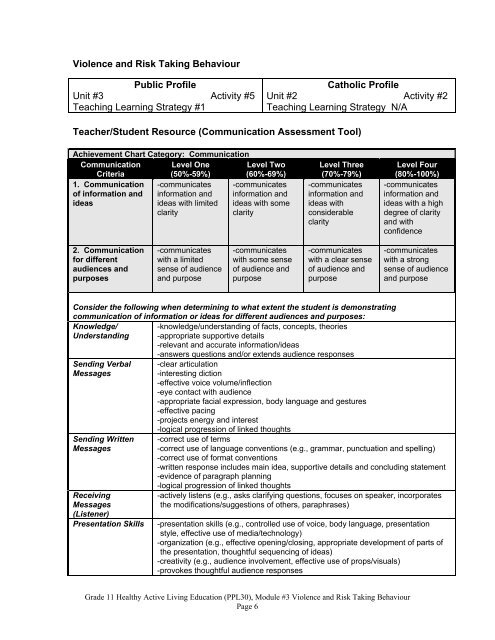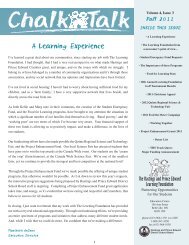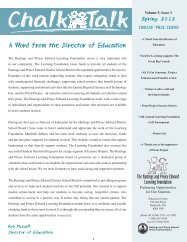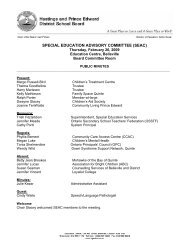Grade 11 Healthy Active Living Education Additional Supports ...
Grade 11 Healthy Active Living Education Additional Supports ...
Grade 11 Healthy Active Living Education Additional Supports ...
You also want an ePaper? Increase the reach of your titles
YUMPU automatically turns print PDFs into web optimized ePapers that Google loves.
Violence and Risk Taking Behaviour<br />
Public Profile<br />
Unit #3 Activity #5<br />
Teaching Learning Strategy #1<br />
Catholic Profile<br />
Unit #2 Activity #2<br />
Teaching Learning Strategy N/A<br />
Teacher/Student Resource (Communication Assessment Tool)<br />
Achievement Chart Category: Communication<br />
Communication Level One Level Two<br />
Criteria<br />
(50%-59%) (60%-69%)<br />
1. Communication -communicates -communicates<br />
of information and information and information and<br />
ideas<br />
ideas with limited ideas with some<br />
clarity<br />
clarity<br />
2. Communication<br />
for different<br />
audiences and<br />
purposes<br />
-communicates<br />
with a limited<br />
sense of audience<br />
and purpose<br />
-communicates<br />
with some sense<br />
of audience and<br />
purpose<br />
Level Three<br />
(70%-79%)<br />
-communicates<br />
information and<br />
ideas with<br />
considerable<br />
clarity<br />
-communicates<br />
with a clear sense<br />
of audience and<br />
purpose<br />
<strong>Grade</strong> <strong>11</strong> <strong>Healthy</strong> <strong>Active</strong> <strong>Living</strong> <strong>Education</strong> (PPL30), Module #3 Violence and Risk Taking Behaviour<br />
Page 6<br />
Level Four<br />
(80%-100%)<br />
-communicates<br />
information and<br />
ideas with a high<br />
degree of clarity<br />
and with<br />
confidence<br />
-communicates<br />
with a strong<br />
sense of audience<br />
and purpose<br />
Consider the following when determining to what extent the student is demonstrating<br />
communication of information or ideas for different audiences and purposes:<br />
Knowledge/ -knowledge/understanding of facts, concepts, theories<br />
Understanding -appropriate supportive details<br />
-relevant and accurate information/ideas<br />
-answers questions and/or extends audience responses<br />
Sending Verbal -clear articulation<br />
Messages<br />
-interesting diction<br />
-effective voice volume/inflection<br />
-eye contact with audience<br />
-appropriate facial expression, body language and gestures<br />
-effective pacing<br />
-projects energy and interest<br />
-logical progression of linked thoughts<br />
Sending Written -correct use of terms<br />
Messages<br />
-correct use of language conventions (e.g., grammar, punctuation and spelling)<br />
-correct use of format conventions<br />
-written response includes main idea, supportive details and concluding statement<br />
-evidence of paragraph planning<br />
-logical progression of linked thoughts<br />
Receiving<br />
-actively listens (e.g., asks clarifying questions, focuses on speaker, incorporates<br />
Messages<br />
the modifications/suggestions of others, paraphrases)<br />
(Listener)<br />
Presentation Skills -presentation skills (e.g., controlled use of voice, body language, presentation<br />
style, effective use of media/technology)<br />
-organization (e.g., effective opening/closing, appropriate development of parts of<br />
the presentation, thoughtful sequencing of ideas)<br />
-creativity (e.g., audience involvement, effective use of props/visuals)<br />
-provokes thoughtful audience responses
















